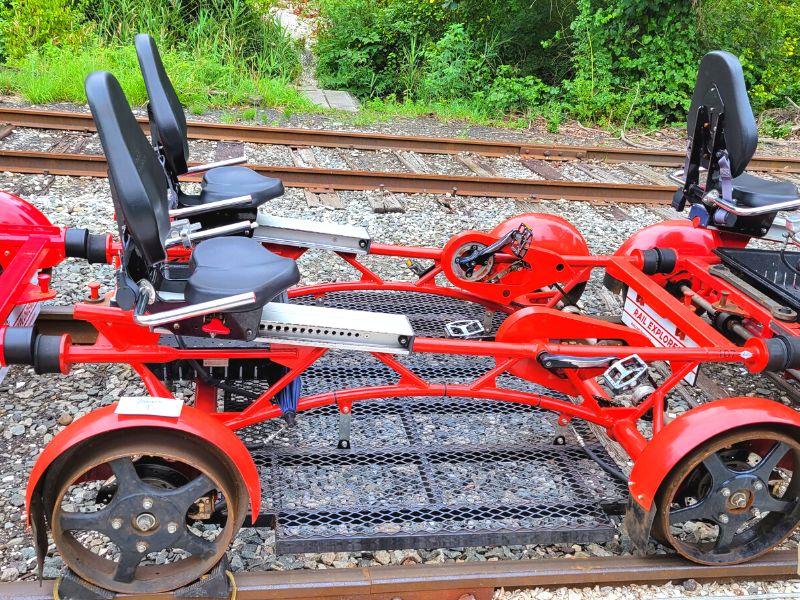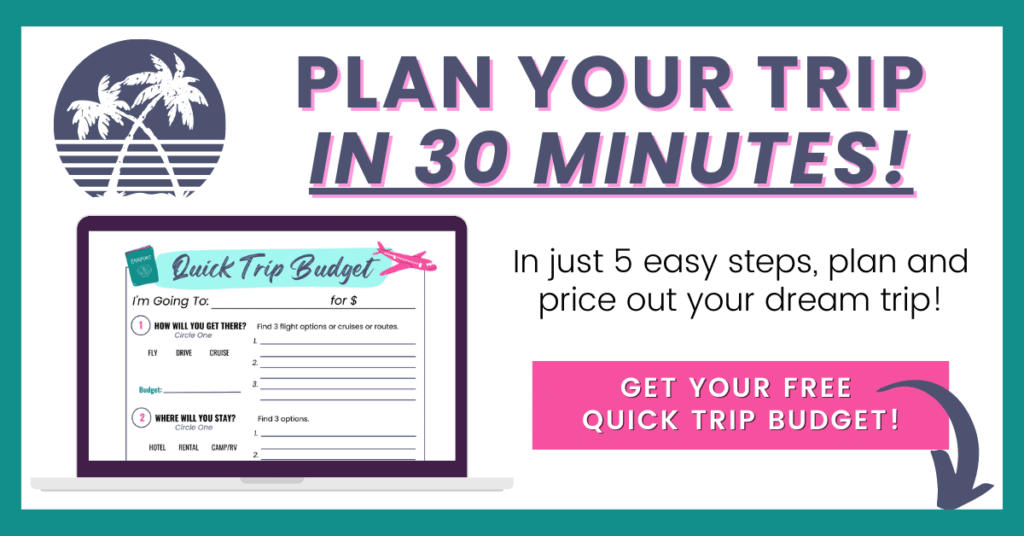You need to save for a trip ahead of time, but how much do you need to go to Hawaii? Or to Europe? Or even that summer national park road trip?
Stop guessing and price it out!
You can’t say you can’t afford a trip when you don’t have any idea how much it actually costs. That’s an attitude problem, not a money problem.
So rather than dumping it all on a credit card and cringing as you pay it back at 25% interest for the next 2 years, let’s make a trip budget, save for it, and then pay it off immediately when the time comes.
I started traveling while still in the middle of paying down student loan debt, and I can tell you from first-hand experience that it’s possible to do both. You just need a plan.
Enter: making a trip budget.
In 5 easy steps you can price out that awesome trip you want to take, and start saving for it now. The key is giving yourself enough time and then sticking to your plan.
But first we need to know how much your trip will cost so we know how much we need to save.
Let’s get started!
Make a Trip Budget in 5 Easy Steps
The most common excuse I hear from others when asked why they don’t travel more is, “I can’t afford it.”
And while not having the savings yet is a valid excuse, what I usually discover when I dig a little deeper is they don’t actually know how much their trip will cost.
They haven’t priced out anything. They just assume any trip they take is going to cost too much.
That’s a negative mindset that will keep you broke and depressed at home when you could be traveling.
So today, I’m sharing how to estimate a trip budget in 5 easy steps.
You can’t say with certainty that you can’t afford a trip if you don’t even have a ballpark estimate.
Let’s figure out how much it could cost first, and then we’ll tackle the how to afford it part later.
Making a trip budget is a powerful thing. It gives you information and the data you need to set a goal and make plans.
It doesn’t lock you into anything. It doesn’t mean you have to take the trip, either.
It’s just a starting point so you know how much that cool trip is going to cost so you can start saving today.
And if it turns out it really is more than you feel comfortable saving for, then we can look at ways to make your trip cheaper. But we’re getting ahead of ourselves.
There are just 5 questions you need to ask to get the info you need to make a trip budget:
- How Will You Get There?
- Where Will You Stay?
- What Will You Eat?
- How Will You Get Around?
- What Will You Do?
Once you get that information, you’ll know how long you’ll need to save up for that trip.

Choosing a Destination
First, you need to already have a destination in mind.
Whether that’s because you’ve always wanted to go to Italy and are ready to start saving or because you found an incredible flight deal you don’t want to pass up, it doesn’t matter.
One of the best ways to save money on travel is to let the deals choose where you go, but I also understand bucket list trips and needing to save up for those years ahead of time.
This trip budget process works for either case.
You just need a general idea of where you’re going to get a rough idea of cost so you can start saving now.
You don’t need to have a detailed itinerary yet. In fact, this cost estimating process will help you start your trip itinerary. But you’ll refine all the details later.
We’ll use a lot of assumptions, rounding, and estimating to get a ballpark figure. That’s all you need to start saving.
Step 1: How Will You Get There?
There are 4 ways to get anywhere: drive, fly, ride, or sail.
The point of this step is to figure out how to get where you’re going and price it out. This is usually the biggest cost of a trip.
Sometimes you need a combination, like getting to St John in the US Virgin Islands. You have to fly to St Thomas first and then take a ferry over to St John.
This is the step to figure that out.
This is not how you will get around once you get where you’re going. We’ll tackle that in step 4.
>> Check 3 options for your chosen transportation.
This means checking flight prices from multiple carriers, comparing regional vs express train or ferry prices, or estimating how much you’ll spend on gas for a road trip.
Don’t worry about which layover or route is best right now. Just check multiple options.
If you’re sailing your own boat or renting one, include all sailing costs here: fuel, mooring and/or dock fees, etc.
For cruises, include the cost of the flight or drive to get to the cruise port in this step, and then add the cost of the cruise either here or in Step 4. Doesn’t matter as long as it’s only accounted for once.

How to Estimate Driving Costs
If you’re driving, your cost is fuel. There’s a simple way to estimate this.
(Mileage of Drive) x (Gas Price per Gallon) / (Fuel Efficiency in MPG)
Estimate the total mileage using Google Maps.
Example: It’s 511 miles from my hometown to Washington, DC, so 1022 miles roundtrip. Gas is $3 per gallon at the moment, and my car gets 30mpg on the interstate.
My estimated fuel cost is 1022 miles x $3 per gallon / 28mpg = $109.50.
If you’re pricing out a road trip looping through several places, use 2-3 stops per day as placeholders so you can get an approximate round trip mileage.
Newer cars calculate your fuel efficiency for you and display it on the dash. If not, you can look up an average online for your car’s year, make, and model.
Check gas prices in your destination by using Google Maps with the find a gas station filter. The price will change before you actually take the trip, of course, but you just need an estimate for now.
How to Check Flight Prices
I use and love Going for finding amazing flight deals, but to compare flights and options I always go to Google Flights.
I like its filters and its pricing information which tells you if it’s high, low, or average price based on past data. This is super helpful if I’m just looking up a destination and not necessarily a deal I already know about thanks to Going.
I can exclude certain airlines, exclude overnight flights, and tell it I don’t want a layover shorter than an hour.
Good to Know: Southwest Airlines doesn’t share its pricing with Google or other flight search sites, so I always do a quick check on their site, too.
You don’t need to be overly picky about layovers and timing right now. You just need an idea of how much flights go for.
You’ll get 3 very average prices. That’s totally fine for estimating.
We’re leaving that cost in the budget for now so you have a buffer in your savings.
If you get a cost savings by using our flight booking tricks later, that’s a bonus.

How to Check Cruise Prices
If you’re a loyalist to a specific cruise line, check their website for 3 potential cruises.
Alternatively, use an aggregate site like Cruises.com to find a cruise that works best for your dates or for the destinations you had in mind. You’re not booking anything right now, so it’s fine to browse all your options.
For cruise pricing, keep in mind that when you book will drastically change the cost. Duh, that’s how all travel works, right? Yes, but it’s especially sensitive for cruises.
Booking early, like a year or more out, and booking last minute, like a month or less out, can yield some incredible discounts. Everything in between a year and a month out is when prices peak.
Cruise lines are also fond of running specials where they’ll include onboard credits or flight credits to “decrease” the cost of the cruise. Be careful of these.
You want a reliable estimate for the cost of the cruise, not a one-time deal price that you can’t get again when it’s time to book.
Step 2: Where Will You Stay?
Hotels are my favorite accommodations, but they’re not the cheapest. Think beyond hotels to see how much you could save with a change in lodging.
This could be camping or RVing, housesitting, staying with friends, a rental, or a hostel.
>> Check whatever options you’re comfortable with, but price out at least three.
Don’t count out hostels. They aren’t just for backpackers anymore. Some have private rooms and baths and family suites. Something to consider.
Caution: If you are a brand loyalist and want to book accommodations with points, make sure you note both the points required and the cash price for your budget.
Redemption values change frequently. You might be able to afford it all on points now when you’re looking 10 months out, but when it’s time to book 3 months out, you might need more points or to pay with cash.
Always have a backup lodging plan in case points fail you at the time of booking.
Don’t spend too long on this step. Doesn’t matter the brand, all mid-range chain hotels will be about the same price. Same goes for rentals with similar amenities or campground sites.
You’re not finalizing your trip details right now. You’re just getting an idea of cost for budgeting and saving purposes.

Step 3: What Will You Eat?
Let’s capture food costs for your trip, and no, that doesn’t mean you need to go make restaurant reservations just yet.
You need an estimate so work with what you know.
>> Come up with approximate costs per meal type. Then, multiply by the number of days you’ll be gone on your trip.
Say $5 for breakfast, $12 for lunch, and $20 for dinner, or whatever makes sense for you.
Don’t forget the ice cream! Add a daily snack budget, too. Better to have it and not need it than need it and not have it.
If you’re taking an international trip or visiting a higher cost of living area than your hometown, check for average meal prices online but don’t get bogged down in looking up dozens of restaurants.
You just need to verify your cost per meal is in the right ballpark. Pick a few restaurants and skim their menus for average prices.
Come up with educated guesses for the cost of each meal, and then move on to the next step.
Step 4: How Will You Get Around?
This step is the hardest to predict, in my experience. You might use Uber, the local metro, and a private airport transfer all on one trip.
But Uber pricing is demand-based, and metro tickets usually cost more on weekends than weekdays.
>> Do your best to estimate, but don’t spend hours trying to think of all scenarios.
Say you’ll take the metro most days and maybe an Uber to get back to the hotel in the evenings. Use that total cost as an average per day transportation cost and multiply it by the number of days of your trip.
Make this simple. Don’t overthink each day, but keep your bases covered.
If you’re planning a multi-city adventure in Italy, for example, be sure to include costs for both getting around the cities that you visit as well as costs for moving between cities.

Step 5: What Will You Do?
Here’s where you’re most likely to go down an internet rabbit hole. Resist the urge!
>> Find just one or two things to do per day of your trip. Spend no more than 15 minutes on this step.
This isn’t meant to be your detailed, finalized itinerary. It’s the highlight reel to help you plan.
Chances are you chose your destination because you already have specific things to do in mind.
Say you’re going to Maui in January for 4 days. You know you want to go on a whale watching tour, see sunrise at Haleakala National Park, and attend a luau.
You don’t need to pick out the exact boat, tour, or luau you’ll attend. You just need an average per person cost for your budget.
Add It Up & Start Saving Today
Now that you have a cost for each step, add them all up and get your total estimated trip cost.
Don’t panic if it’s higher than you want it to be!
This is an estimate and it should be a little higher than what you’re actually going to pay in the end.
You have months to save and months to refine and reduce those costs.
The key is to start saving now, so you have the luxury of time to work on bringing down costs before your trip.
If your finances can only accommodate so much savings per month, think of ways to make a side income to help fund your trip faster.
Get Your Own Quick Trip Budget PDF
Need a place to keep track of your trip budget? Here’s a FREE, simple-to-use, fillable PDF that follows this 5 step process for estimating a trip budget, and it does the math for you.
Use it as many times as you want, creating a trip budget for every trip on your calendar!

Figure out how much your trip will cost so you can start saving today! Knowledge is power.
Happy Travels!

About the Author: Rachel Means
With six-figure student loan debt and only 10 PTO days per year, Rachel started traveling the world. A decade later, she’s paid off her loans, changed careers, and been to 36 US states and 14 countries. She’s an expert at planning and budgeting for travel and loves to help others do it, too! Read her full story here.
Share It!


